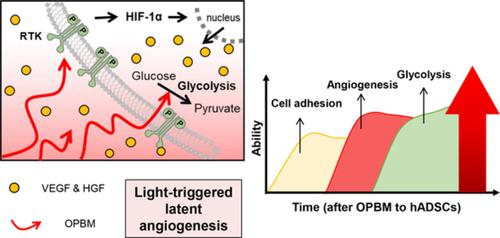当前位置:
X-MOL 学术
›
Bioeng. Transl. Med.
›
论文详情
Our official English website, www.x-mol.net, welcomes your feedback! (Note: you will need to create a separate account there.)
Area light source-triggered latent angiogenic molecular mechanisms intensify therapeutic efficacy of adult stem cells
Bioengineering & Translational Medicine ( IF 7.4 ) Pub Date : 2021-09-14 , DOI: 10.1002/btm2.10255 Yu-Jin Kim 1 , Sung-Won Kim 1 , Gwang-Bum Im 1 , Yeong Hwan Kim 1 , Gun-Jae Jeong 2 , Hye Ran Jeon 3 , Dong-Ik Kim 2 , Haeshin Lee 4 , Sung Young Park 5 , Sung Min Cho 1 , Suk Ho Bhang 1
Bioengineering & Translational Medicine ( IF 7.4 ) Pub Date : 2021-09-14 , DOI: 10.1002/btm2.10255 Yu-Jin Kim 1 , Sung-Won Kim 1 , Gwang-Bum Im 1 , Yeong Hwan Kim 1 , Gun-Jae Jeong 2 , Hye Ran Jeon 3 , Dong-Ik Kim 2 , Haeshin Lee 4 , Sung Young Park 5 , Sung Min Cho 1 , Suk Ho Bhang 1
Affiliation

|
Light-based therapy such as photobiomodulation (PBM) reportedly produces beneficial physiological effects in cells and tissues. However, most reports have focused on the immediate and instant effects of light. Considering the physiological effects of natural light exposure in living organisms, the latent reaction period after irradiation should be deliberated. In contrast to previous reports, we examined the latent reaction period after light exposure with optimized irradiating parameters and validated novel therapeutic molecular mechanisms for the first time. we demonstrated an organic light-emitting diode (OLED)-based PBM (OPBM) strategy that enhances the angiogenic efficacy of human adipose-derived stem cells (hADSCs) via direct irradiation with red OLEDs of optimized wavelength, voltage, current, luminance, and duration, and investigated the underlying molecular mechanisms. Our results revealed that the angiogenic paracrine effect, viability, and adhesion of hADSCs were significantly intensified by our OPBM strategy. Following OPBM treatment, significant changes were observed in HIF-1α expression, intracellular reactive oxygen species levels, activation of the receptor tyrosine kinase, and glycolytic pathways in hADSCs. In addition, transplantation of OLED-irradiated hADSCs resulted in significantly enhanced limb salvage ratio in a mouse model of hindlimb ischemia. Our OPBM might serve as a new paradigm for stem cell culture systems to develop cell-based therapies in the future.
中文翻译:

区域光源触发的潜在血管生成分子机制增强了成体干细胞的治疗效果
据报道,基于光的疗法如光生物调节 (PBM) 在细胞和组织中产生有益的生理效应。然而,大多数报告都集中在光的直接和即时影响上。考虑到自然光照射对生物体的生理影响,应考虑照射后的潜伏反应期。与之前的报道相比,我们使用优化的照射参数检查了光照后的潜伏反应期,并首次验证了新的治疗分子机制。我们展示了一种基于有机发光二极管 (OLED) 的 PBM (OPBM) 策略,该策略通过直接照射具有优化波长、电压、电流、亮度和期间,并研究了潜在的分子机制。我们的研究结果表明,我们的 OPBM 策略显着增强了 hADSCs 的血管生成旁分泌效应、活力和粘附性。在 OPBM 治疗后,HIF-1α 表达、细胞内活性氧水平、受体酪氨酸激酶的激活和 hADSC 中的糖酵解途径均观察到显着变化。此外,在后肢缺血小鼠模型中,OLED 照射的 hADSCs 的移植显着提高了保肢率。我们的 OPBM 可能会成为干细胞培养系统未来开发细胞疗法的新范例。在 OPBM 治疗后,HIF-1α 表达、细胞内活性氧水平、受体酪氨酸激酶的激活和 hADSC 中的糖酵解途径均观察到显着变化。此外,在后肢缺血小鼠模型中,OLED 照射的 hADSCs 的移植显着提高了保肢率。我们的 OPBM 可能会成为干细胞培养系统未来开发细胞疗法的新范例。在 OPBM 治疗后,HIF-1α 表达、细胞内活性氧水平、受体酪氨酸激酶的激活和 hADSC 中的糖酵解途径均观察到显着变化。此外,在后肢缺血小鼠模型中,OLED 照射的 hADSCs 的移植显着提高了保肢率。我们的 OPBM 可能会成为干细胞培养系统未来开发细胞疗法的新范例。
更新日期:2021-09-14
中文翻译:

区域光源触发的潜在血管生成分子机制增强了成体干细胞的治疗效果
据报道,基于光的疗法如光生物调节 (PBM) 在细胞和组织中产生有益的生理效应。然而,大多数报告都集中在光的直接和即时影响上。考虑到自然光照射对生物体的生理影响,应考虑照射后的潜伏反应期。与之前的报道相比,我们使用优化的照射参数检查了光照后的潜伏反应期,并首次验证了新的治疗分子机制。我们展示了一种基于有机发光二极管 (OLED) 的 PBM (OPBM) 策略,该策略通过直接照射具有优化波长、电压、电流、亮度和期间,并研究了潜在的分子机制。我们的研究结果表明,我们的 OPBM 策略显着增强了 hADSCs 的血管生成旁分泌效应、活力和粘附性。在 OPBM 治疗后,HIF-1α 表达、细胞内活性氧水平、受体酪氨酸激酶的激活和 hADSC 中的糖酵解途径均观察到显着变化。此外,在后肢缺血小鼠模型中,OLED 照射的 hADSCs 的移植显着提高了保肢率。我们的 OPBM 可能会成为干细胞培养系统未来开发细胞疗法的新范例。在 OPBM 治疗后,HIF-1α 表达、细胞内活性氧水平、受体酪氨酸激酶的激活和 hADSC 中的糖酵解途径均观察到显着变化。此外,在后肢缺血小鼠模型中,OLED 照射的 hADSCs 的移植显着提高了保肢率。我们的 OPBM 可能会成为干细胞培养系统未来开发细胞疗法的新范例。在 OPBM 治疗后,HIF-1α 表达、细胞内活性氧水平、受体酪氨酸激酶的激活和 hADSC 中的糖酵解途径均观察到显着变化。此外,在后肢缺血小鼠模型中,OLED 照射的 hADSCs 的移植显着提高了保肢率。我们的 OPBM 可能会成为干细胞培养系统未来开发细胞疗法的新范例。



























 京公网安备 11010802027423号
京公网安备 11010802027423号